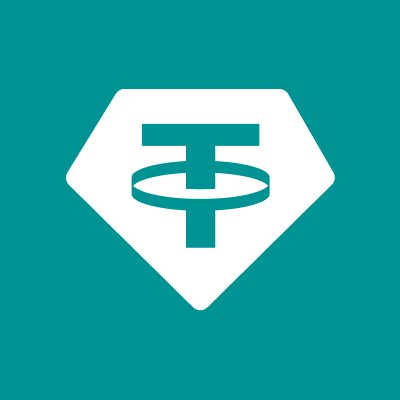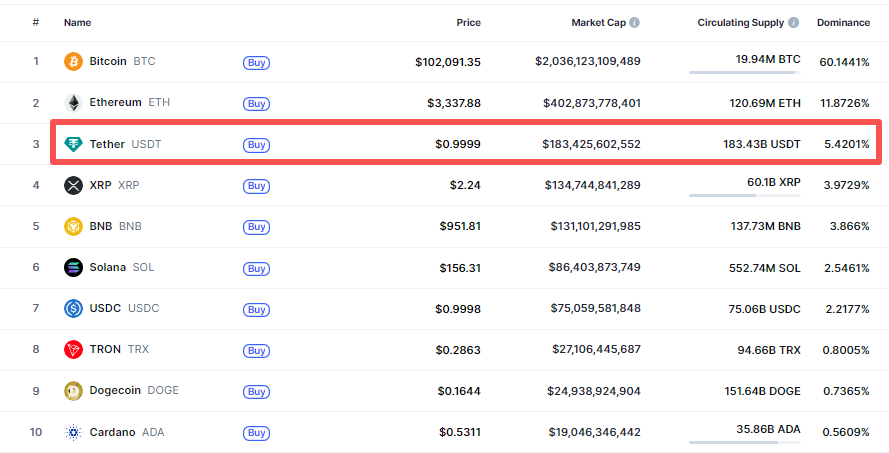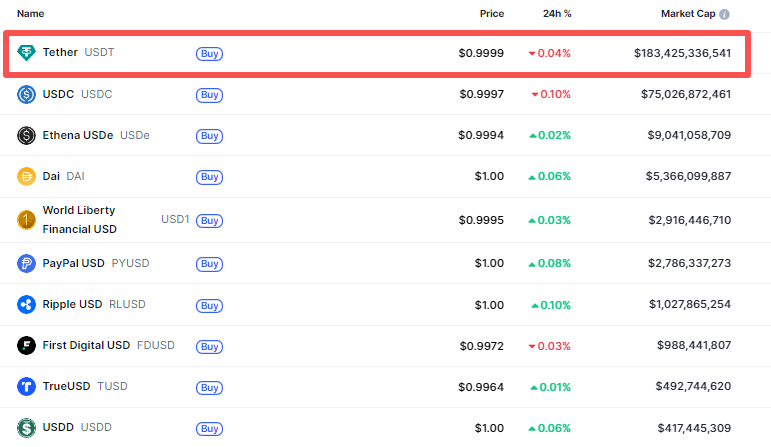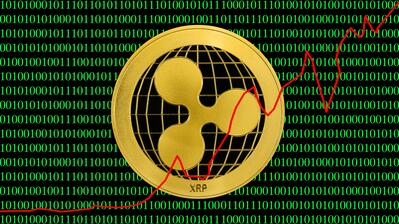What Is Tether (USDT)? Is Tether a Scam? How to Buy USDT

Tether USDT Latest News
TradingKey – On November 4, the crypto market plunged into panic, prompting investors to seek refuge in stablecoins. Tether (USDT) surged past a market cap of $180 billion, setting a new all-time high. Just days earlier, Tether CEO Paolo Ardoino hinted that USDT could eventually reach a $1 trillion market cap.
 USDT Market Cap – Source: CoinMarketCap.
USDT Market Cap – Source: CoinMarketCap.
This surge has translated into massive profits for Tether. As of Q3 2025, USDT boasts over 500 million users, and Tether’s cumulative profit for the year has exceeded $10 billion. The company now holds more than $130 billion in U.S. Treasuries, ranking it as the 17th largest holder of U.S. government debt globally — ahead of many sovereign nations.
Despite its dominance, USDT remains misunderstood by many newcomers. Is it legal? Is it a scam? Can you profit from it? This guide breaks down USDT’s mechanics, risks, and how to buy it safely.
What Is Tether (USDT)?
Tether (USDT) is a stablecoin pegged to the U.S. dollar, designed to provide price stability in the volatile crypto ecosystem. It functions as a digital dollar on blockchain, enabling fast, low-cost transactions, acting as a store of value, and serving as a bridge between crypto assets and fiat currencies.
Founded in 2014 by Brock Pierce, Reeve Collins, and Craig Sellars, USDT was initially launched on the Bitcoin blockchain via the Omni Layer. It expanded to Ethereum in 2017, and now exists on over 100 blockchains, including Solana, Tron, Avalanche, and Polygon — making it the most widely deployed stablecoin in the world.
Is USDT the Same as USD?
While USDT is designed to maintain a 1:1 peg with the U.S. dollar, it differs significantly in structure, backing, and legal status:
Attribute | Tether (USDT) | U.S. Dollar (USD) |
Issuer | Tether Limited (private company) | U.S. Federal Reserve |
Backing | Claims reserves in cash, T-bills, commercial paper | Backed by sovereign credit and monetary policy |
Legal Status | Crypto asset, not legal tender | Official legal tender |
Redemption | Requires KYC, minimum thresholds, and Tether approval | Freely redeemable via banks |
Transparency | Periodic attestations, limited audits | Full public disclosures via central banks |
Regulation | Subject to crypto and payments scrutiny | Protected by mature financial laws |
Use Case | Crypto settlement, trading, DeFi | Global commerce, banking, reserves |
What Is USDT Used For?
USDT plays a critical role in the crypto economy:
- Trading Pairs: Most crypto assets are traded against USDT (e.g., BTC/USDT, ETH/USDT), making it the default pricing unit.
- Safe Haven: During market volatility, investors convert assets to USDT to preserve value.
- Cross-Chain Liquidity: USDT’s multi-chain presence allows seamless transfers between exchanges and blockchains.
- OTC Settlement: Used in over-the-counter trades and market-making operations.
- DeFi Utility: Powers lending, liquidity pools, and yield farming strategies.
- Payments: Enables fast, low-cost cross-border payments and remittances.
Pros and Cons of USDT
Advantages
- High Liquidity: USDT is the most traded stablecoin, with deep liquidity across all major exchanges.
- Universal Acceptance: Supported by nearly every centralized and decentralized platform.
- Fast & Cheap Transfers: Especially on Layer-2 networks like Arbitrum and Tron, fees are minimal and speeds are near-instant.
Disadvantages
- Centralization Risk: Tether’s dominance creates systemic risk if the issuer fails.
- Transparency Concerns: Audits and reserve disclosures have been criticized for lack of clarity.
- Freezability: Tether can freeze USDT held in specific wallets under law enforcement request.
- Regulatory Pressure: Global regulators are increasingly scrutinizing stablecoins, which may lead to restrictions or delistings.
Despite these risks, USDT has remained resilient and continues to dominate the stablecoin sector.
USDT Market Status
Since its inception, Tether (USDT) has seen continuous growth in circulation, with its market capitalization reaching $183.4 billion. This accounts for over 5% of the total crypto market cap, making USDT the third-largest cryptocurrency, trailing only Bitcoin (BTC) and Ethereum (ETH), and far ahead of other major tokens like XRP, BNB, and SOL.
 Top 10 Cryptocurrencies by Market Cap – Source: CoinMarketCap.
Top 10 Cryptocurrencies by Market Cap – Source: CoinMarketCap.
From a sector perspective, USDT is the largest stablecoin, commanding more than half of the entire stablecoin market—a share greater than all other stablecoins combined. According to the latest data, the total stablecoin market cap stands at $314.6 billion, with:
- USDT holding a 58% share
- USDC in second place with less than 24%
- USDe in third with around 3%
These figures clearly show that Tether has established a near-monopoly in the stablecoin space, dominating both centralized and decentralized crypto ecosystems.
 Top 10 Stablecoins by Market Cap – Source: CoinMarketCap.
Top 10 Stablecoins by Market Cap – Source: CoinMarketCap.
What Is USDT’s Price?
USDT is designed to trade at $1, but its price can fluctuate slightly due to market dynamics. Minor deviations (±0.5%) are common across exchanges or blockchains. In extreme cases, USDT has dropped to $0.91 or surged to $1.08, often triggered by regulatory news or liquidity shocks.
 USDT Price Chart – Source: CoinMarketCap.
USDT Price Chart – Source: CoinMarketCap.
If USDT trades significantly off its peg, it may signal exchange-specific issues, on-chain redemption pressure, or broader market stress.
Is USDT Legal?
In most jurisdictions, holding USDT is legal, but its issuance and use must comply with local laws. Regions like the U.S., EU, Singapore, and Hong Kong have frameworks that support regulated stablecoin use.
However, China has banned all crypto trading and issuance, including USDT. OTC trading or exchange operations involving USDT in mainland China are considered illegal and lack legal protection.
Globally, using USDT for money laundering or terrorist financing is strictly prohibited. Users must be able to verify the source of funds and avoid transferring USDT to unregulated platforms.
Is Tether a Scam?
USDT itself is not a scam, but its widespread use makes it a frequent target for fraud. Common USDT-related scams include:
- Pig-butchering scams: Fraudsters build trust via social media, then lure victims to fake investment platforms that accept USDT.
- Fake support scams: Impersonators posing as exchange or wallet staff ask for private keys or transfers to “secure” addresses.
- Counterfeit USDT tokens: Scammers deploy fake tokens with the same name on obscure chains and sell them to unsuspecting users.
- Fake OTC brokers: Fraudsters request USDT upfront and disappear without delivering assets.
To stay safe, only use regulated exchanges like Binance, Coinbase, or licensed OTC desks. Never share your private keys, seed phrases, or 2FA codes with anyone.
How to Buy USDT
Option: Centralized Exchange (Recommended for Beginners)
Step 1: Register and Verify Identity
- Visit Binance, Coinbase, or other major exchange
- Sign up with phone/email
- Complete KYC (upload ID documents)
Step 2: Deposit Fiat Currency
- Use debit/credit card, bank transfer, or local payment methods
- Supported currencies: USD, HKD, TWD, etc.
Step 3: Buy USDT
- Navigate to “Buy Crypto” or “Quick Buy”
- Select fiat currency and USDT
- Enter amount, review fees, confirm transaction
- USDT will be credited to your account instantly
Conclusion
Tether (USDT) is the backbone of crypto liquidity and settlement. Its utility is unmatched, but its risks — centralization, transparency, and regulatory exposure — require careful consideration. While USDT itself is not fraudulent, it’s often used in scams due to its popularity and ease of transfer.
For investors and users, the key is vigilance: use trusted platforms, verify token authenticity, and never compromise your wallet security. USDT is a powerful tool — but like any tool, it must be used wisely.
FAQ
Q: Can I buy USDT with a credit card? Yes, most exchanges support it, but fees may be higher and limits apply.
Q: What if I send USDT to the wrong address? Blockchain transactions are irreversible. Always double-check the address and test with a small amount first.
Q: How do I verify USDT authenticity? Use a blockchain explorer to check the token’s contract address and compare it with official listings. Avoid unknown airdrops or suspicious tokens.








